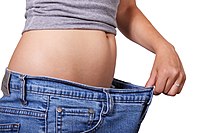
Photo from wikipedia
BackgroundTo evaluate the efficacy of stoss therapy using fortified biscuit for vitamin D-deficient children.MethodsA total of 108 children aged 30–72 months with vitamin D deficiency were studied in a randomized… Click to show full abstract
BackgroundTo evaluate the efficacy of stoss therapy using fortified biscuit for vitamin D-deficient children.MethodsA total of 108 children aged 30–72 months with vitamin D deficiency were studied in a randomized single-blind clinical trial. The deficient children were assigned to three groups, namely, vitamin D-fortified biscuit (BG), capsule vitamin D (CG), and ampoule vitamin D (AG). Capsules and biscuits containing 50,000 IU of cholecalciferol were consumed twice per week for 3 consecutive weeks. Ampoules with 300,000 IU of cholecalciferol were injected intramuscularly in a single dose. Three weeks after treatment, serum 25(OH)D concentrations were measured, and the three groups were compared.ResultsEach method of treatment could increase the mean serum 25(OH)D concentration to optimal level. Serum 25(OH)D concentrations ≥100 ng/mL were observed in six children, including four from AG and two from CG (P = 0.09). The comparison of the mean serum 25(OH)D concentrations after treatment showed between ampoule and capsule (P = 0.3) and capsule and biscuit (P = 0.62) were insignificant; however, the ampoule and biscuit groups differed significantly (P = 0.012).ConclusionStoss therapy using fortified biscuit may be an effective way to improve compliance in children who cannot take capsules without adverse effects and may also be recommended for prevention purposes.
Journal Title: Pediatric Research
Year Published: 2018
Link to full text (if available)
Share on Social Media: Sign Up to like & get
recommendations!